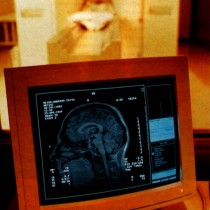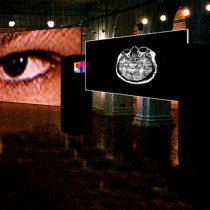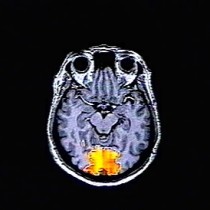Mind’s Eye
Mind’s Eye – An installation for 3 projectors, 2 monitors & 4 video players. (1997)
“The mind’s eye begins to see clearly, when the outer eyes grow dim.” Plato, Symposium
For me, Mind’s Eye is about the relationship between looking and understanding. In this installation I am interested in particular notions of light- the interrelated ‘light’ of the eye and of the mind.
Physically, within the space of the installation, images of ‘seeing’ and ‘understanding’ are presented by imaging machines in various forms, and explicitly these machines are themselves productions of the human mind. Sited at the heart of the piece is a projected image of the brain, produced via a camera device which is itself an ‘electronic eye’ for looking into that organ which is the seat of human understanding. The two cameras on either side of the screen are ‘eyes’ too, but without the reason behind them that endows our eyes with their power. Making sense of the images formed by these electronic eyes is the task of the viewer.
- fMRI scanning session for “Mind’s Eye”, (1996)
The darkened space of the gallery is illuminated by various projected and back-lit images, which are in turn imaged by cameras or reflected back into the eye and mind of the viewer. The two projected eyes of Mind’s Eye are blind- the images which are keyed into each iris do not signify ‘looking’ but reflection- the reflection of the active viewer. For us sight is about participation, as both looking and seeing require active thought. It is also important to see that the view that our technology gives us of ourselves is anything but objective:
We need to soften the notion of ourselves as equipped with fixed vidiconlike eyes and static computerlike brains to produce the equivalent of consciousness. Arthur Zajonc, Catching the Light
The installation Mind’s Eye grew out of my interest in developing a way of presenting images to represent flowing thought. I was inspired by an article in New Scientist (“Have the Mind Mappers Lost Their Way”, May 4th, 1996) which reported on a controversy about the interpretation of results of fMRI (functional Magnetic Resonance Imaging) and PET (Positron Emmission Tomography) experiments designed to map areas of the human brain. I was particularly interested to discover that these brain scan techniques relied on the detection of variations in the flow of oxygenated blood within the brain, and on the assumption that this was related to neural activity. An idea then developed from the notion that if I could have a series of brain scans produced whilst looking at a pre-determined visual stimulus, it would be possible to re-present the resultant brain scans and visual stimuli in synchronisation within the context of a gallery installation. It seemed to me that regardless of the problems of any scientific interpretation of these images, they were nevertheless images of flowing activity associated with the process of human thought. Within the context of fine art, these images were a representation of the interior of the brain- they show the record of flowing activity inside the head. I was particularly interested in the fact that the technology in question was also a product of the human mind, and had come about as a direct result of the self-reflexive properties of human consciousness. In this installation I am presenting the technology as an example of the subjective human mind looking at itself- literally a “mind’s eye “.
The principle image in the installation is a representation of the human brain. In this particular case, it is an fMRI image of the artist’s brain, but it is important to an understanding of the intentions of the work that the individual viewer recognises its’ similarity to his/her own brain, and that the activity presented on the screen matches an identical process taking place within their own brain when looking at the stimulus on the video monitor.
The fMRI scans are images of the human mind looking at itself. The technology to present the images and the mind looking at the screen are both the product of human consciousness- the power of the brain to be aware of itself and to make sense of the body it is part of. But the brain activity mapped by the scan is not a record of consciousness- it is simply a representation of two aspects of visual perception- colour and motion. The human brain divides visual perception into a number of constituent parts, colour, form, motion, etc. and then miraculously recombines them in synch.
In my installation the “mind’s eye” is not the machine that produces images of the brain, but the self-reflexive mind of the viewer who reflects on his/her own perception at the point of looking at the work. My work is at a significant level “participatory”. Not only is the work something to be physically experienced by moving around the space, but the active mind connects the elements of the installation to what s/he brings to the work. In Mind’s Eye I am attempting to make explicit that which was implicit in earlier installations such as Eau d’Artifice, (1990) Streamline, (1991) and Vortex (1995). As with these earlier works, Mind’s Eye is about “flow”- the flow of images, the flow of blood through the brain to the visual cortex (for that is what the fMRI process is in effect measuring) the flow of information, etc. Most importantly however, it is an attempt to make tangible the flow of perception and cognition, to make a link between the act of looking at a work of art and making sense of it, an interactive relationship between the body and the mind, between looking, thinking and emotional and physical experience.
June, 1997.
Mind’s Eye: A New Video Installation by Chris Meigh-Andrews
Projected in the darkened gallery is a striking central image of a scanned human brain, flanked by a flow of colours and words on two video monitors, and by two larger diagonal screens which carry projected images of the human eye among the flux or bundle of sensations- light, contrast, scale, colour- which the viewer first confronts, these projected images of eyes and brain command attention and focus. But the work is sculptural as well as pictorial, inviting us to move around it, from screen to screen, and to make connections. The duration of the piece includes the time which the viewer takes to participate in it. Installed as a continuous performance, it “opens” whenever a new visitor decides to enter the public forum of the viewing space.
The process of viewing here retraces the stages of making, since the brain scan image records the artist’s own neural response to the visual stimuli of those shapes and colours we see for ourselves on the monitor. Our own physical reactions to the changing colours and the image movement are mirrored in the synchronised responses of the brain scan, which charts the flow of blood in the visual cortex. But this leap of recognition between the viewer and the artist is not all. To see a colour is one process, to measure colour data is another. here the brain’s visible reaction to colour and movement (on one of the monitors) is encoded by another set of signals (in video projection) whose parallel colours and sequencing are electronically sourced by camera and computer. By relaying colour words and other images onto the iris of the two large scale projected eyes, Mind’s Eye suggests that we are seeing nothing directly or without mediation, invoking the metaphor implied in its title.
Such earlier videos as The Stream (1987) suggest an internalist model of perception, in which the eye is never innocent, as Ruskin thought, of the words or categories which shape what we see. This new installation shifts its vantage point to match an expansion into multi screen projection of images and words. By separating out the levels of text and picture into adjacent spaces, the spectator is free to reconstitute and question their relationship. Just as neuropsychology confirms that the visual cortex is specialised for different attributes of vision, so Mind’s Eye allows for that distinct and irreducible element in visual perception which, in other situations, means that the stick always looks bent under water even when we know it is not.
At the same time, this more externalised or specific account of seeing is also aware that a map of the neural response path can yield no more information about how our sensations feel to us than a sleeper’s EEG can show the contents of a dream it charts. “The brain activity mapped by the scan is not a record of consciousness” says Meigh-Andrews, “it is simply a representation of two aspects of visual perception: colour and motion”. These gaps between source and trace, and between image and name, are explored in the work itself, for example in the viewer’s creative response to colour fields and their descriptive names shown on the monitors.
Mind’s Eye fuses artistic and scientific research, and impulse in modern art since Impressionism and Cubism. Intellectually, the work draws on current speculation about mind, brain and human psychology. These theories share with contemporary art a concern for identity and consciousness, while the scientific application of “pure” abstract colours and shapes to stimulate neural response inevitably recalls the purist or “universal language’ of form and motion explored by the film avant-garde from Richter, Fischinger and Eggeling to Sharits and Brakhage. Since modern art, physics, neurology and optics all emerged between the synaesthetic 1880’s and the constructivist 1920’s, it is apt that the computerised colour program display used here to generate stimuli for the brain-scan is named after Mondrian.
This fully contemporary work also posits some further historic echoes, its very shape recalling the cameras obscura (an early vision machine, and a potent model of mind for the 17th century), while allusions to the ritual art of the cave ay also embrace Plato’s influential allegory of illusion. Clues to this archaic level of the work include its darkness, the spacing and configuration of its screens and an authoritative central image in the layered and open skull. Evoking primary and bodily sensations (“the head is soverign”, said Giacometti), this image puns on the skull as an ancient emblem of death or memento mori even as it scans, and so digitally remembers, a living interiority. Tracking blood flow to locate neural consciousness is a startling flash-forward of Empedokles’ ancient intuition that we think with our blood. Allusions to “the enlightenment” in art, science and philosophy are also part of the mental map of Mind’s Eye. Both “the new philosophy” of cognition in Descartes or Locke, and the refashioned post-Cartesian “new physics” of today, echo in its structure.
The work affirms a broadly holistic philosophy of “flow” between observer and observed, in which levels of perception and meaning interchange through the consciousness of the spectator. But it is tough-minded in its naturalism. Its different elements- variations of screen and scale, of looking and reading- converge only through the active, cognitive participation of the viewer. This response enters the work as a new- unforclosed and unpredictable- part of its meaning. A literal “self-portrait” of the artist, suitable enough caught in the act of colour perception, leads the viewer to encounter his or her own sense of vision.
Refreshingly among the newest installation art, the work neither seeks to absorb its viewers in lavish spectacle (as does Bill Viola) nor to split and fracture them in the abjection of psycho-fantasy (as with Douglas Gordon). It is perhaps more closely related to the play between science and art in Mona Hatoum and Judith Goddard, or to the interactive sculpture of Jim Campbell. The artist himself refers, among others, to Michael Snow (for acknowledging narrative and metaphor) and to Chris Welsby who recognised “the interaction of the cinematic apparatus as an active process in relation to a view of natural phenomena”).
Mind’s Eye adds a new dimension to Chris Meigh-Andrews’ “post minimal” video and installation sculpture, although many of its themes expand on earlier concerns- words set against image, the mixture of pre-recorded an live video and an abiding concern for “parallel flow” or continuum from the work of art to the spectator. His work relies on personal, often lyrical ideas which have a decidedly social interface (as with visual perception). This work, I think, is his first to exploit “hidden’ aspects of vision in the sphere of scientific knowledge in contrast to the more familiar and given world of dailyness, or to such works as The Stream, in which flowing water also refers analogically to the movement of human awareness.
In rendering the invisible visible, Mind’s Eye brings medical science and participatory art together in a public and accessible context. It engages with its audience as an independent work, but- as with such scholars of vision as EH Gombrich, Michael Podro and Michael Baxandall in his book Shadows and Enlightenment (1995), apply the test of “ecological validity” to the pycho-physical stimuli in programs such as “Mondrian’, to check the relevance of the test stimulus against “the complexity of real experience”. Mind’s Eye yields nothing to that complexity while, as process-based art, it makes a new and lucid contribution to the ecology of vision.
Al Rees, London , July 1997.


